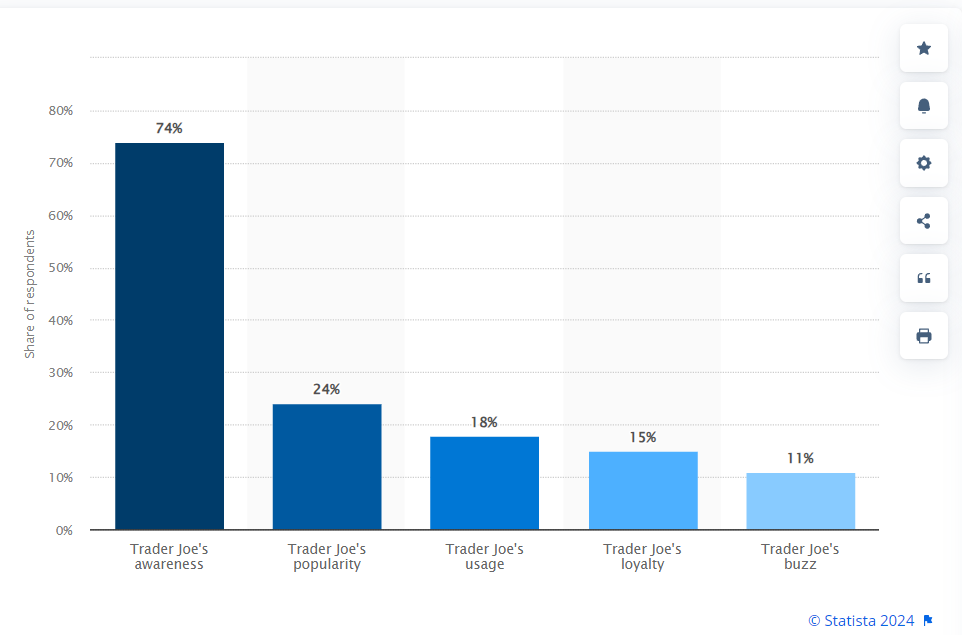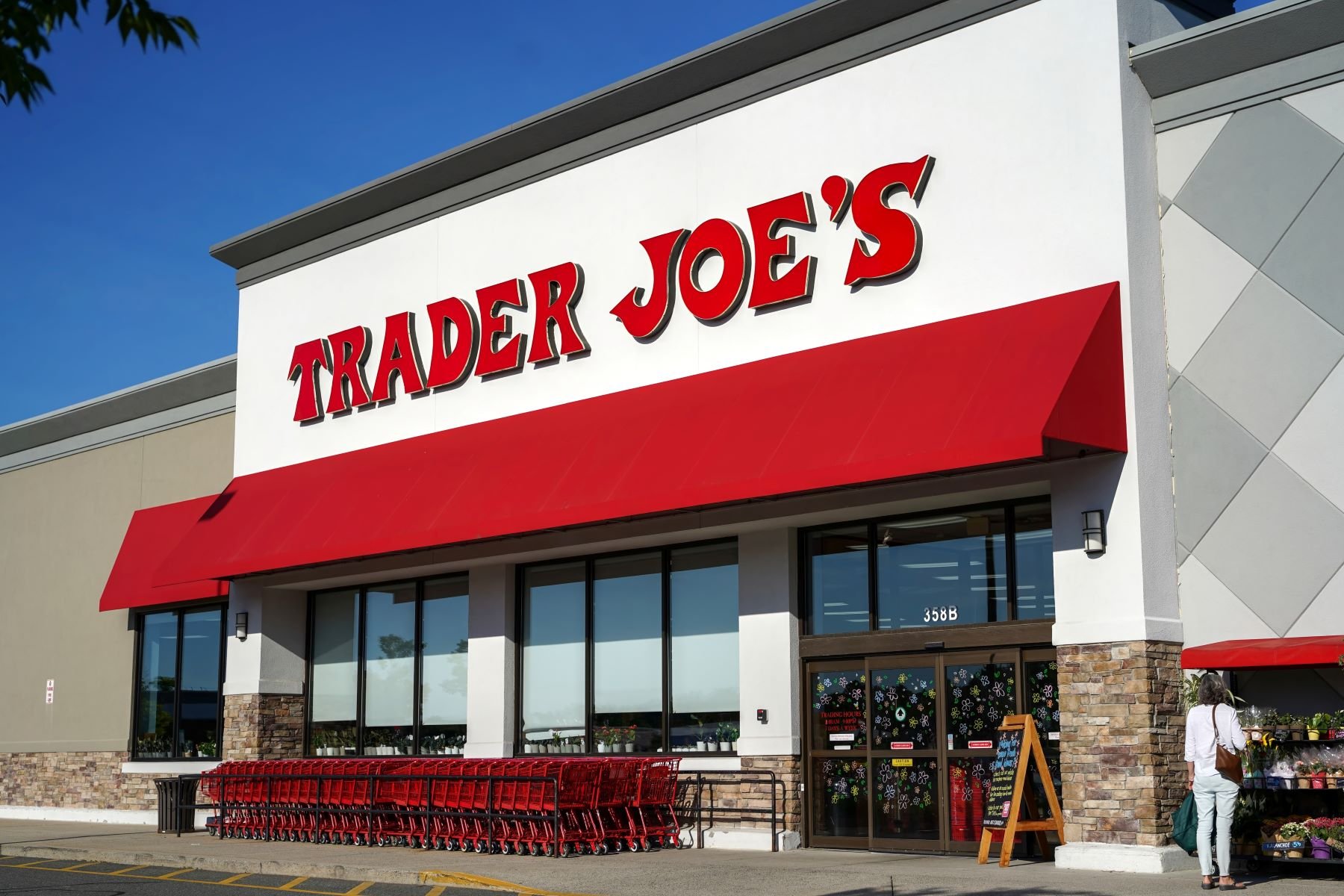Trader Joe’s, an innovative and beloved grocery chain in the United States, has become a market leader through its unique marketing strategy and customer-centric approach. It is known for its quirky atmosphere, private label products, and exceptional customer service. Trader Joe’s stands out in the highly competitive grocery industry. This document will analyze the key elements of Trader Joe’s marketing strategy, highlighting the tactics that have contributed to its success.
No time to spare? Listen on the go!
The history of the leading US grocery retailer, Trader Joe’s
Trader Joe’s, founded by Joe Coulombe in 1967 in Pasadena, California, started as a modest chain of convenience stores but soon evolved into a beloved grocery store with a distinctive identity. Coulombe’s vision was to create a store that offered high-quality products at affordable prices, focusing on private labels to keep costs low and quality high. The store’s quirky, island-themed atmosphere, complete with Hawaiian shirts for employees, became a hallmark of its brand, adding to its unique charm.
Over the years, Trader Joe’s has achieved numerous milestones. In 1979, the company was acquired by German billionaire Theo Albrecht, co-founder of Aldi Nord, which helped fuel its expansion. Today, with over 500 stores across the U.S., Trader Joe’s has become a staple in American culture, often recognized for its cult following and customer loyalty.
Trader Joe’s has won numerous awards, including being named “America’s Favorite Grocery Store” in several consumer surveys. Despite its success, the company has faced some controversies, including criticism over its product sourcing practices and labor conditions. However, Trader Joe’s has remained committed to its core values of offering unique products, exceptional customer service, and maintaining a fun, welcoming shopping environment.
Trader Joe’s business performance: Key metrics

Trader Joe’s has consistently outperformed its competitors regarding revenue per square foot and customer loyalty. Below are key metrics illustrating its market dominance:
- Revenue evolution: Trader Joe’s revenue has steadily increased, reaching an estimated $16.5 billion in 2023.
- Market share: As of 2023, Trader Joe’s holds a significant share of the specialty grocery market, with a loyal customer base that frequently chooses it over larger grocery chains.
- Sales per square foot (SPSF): Trader Joe’s leads the grocery industry with a remarkable SPSF of approximately $1,750, which is significantly higher than competitors like Walmart ($400) and Target ($300).
- Private label success: Around 80% of Trader Joe’s products are private labels, which enables the company to offer high-quality items at lower prices by cutting out the middleman. This strategy has cultivated a strong following, with items like Mandarin Orange Chicken becoming customer favorites.
- Limited SKU strategy: Trader Joe’s stocks around 4,000 SKUs, far fewer than the average grocery store, which typically carries 30,000. This curated selection ensures that only the best products make it to the shelves, enhancing the shopping experience and driving customer loyalty
- Operational efficiency: The streamlined supply chain of Trader Joe’s allows it to maintain low prices without compromising quality. The company efficiently moves products and maximizes turnover by ordering products in bulk and managing a smaller inventory.
- Customer engagement: Trader Joe’s focuses heavily on word-of-mouth marketing and social media rather than traditional advertising. This strategy, combined with its policy of empowering employees to enhance customer service, helps maintain a strong and loyal customer base.

Build smarter customer journeys and activate AI-driven personalization for repeat purchases.
Decrypting the Trader Joe’s business model
Extensive product differentiation
Trader Joe’s offers a variety of unique products, many of which are sourced directly from suppliers around the world. This allows them to maintain high quality while keeping prices low. Focusing on private label products helps build brand loyalty and ensures customers associate the unique offerings directly with Trader Joe’s.
Sustainable community building
Trader Joe’s stores often host local events, tastings, and community gatherings that foster a sense of belonging and community involvement. This focus helps build strong customer relationships and enhances brand loyalty.

Top-notch customer engagement and loyalty
The brand engages customers through personalized in-store interactions and responsive social media engagement. Their Fearless Flyer newsletter is a standout example, offering a mix of product information, recipes, and engaging content that keeps customers excited about shopping at Trader Joe’s.
Unique in-store experience
The in-store experience at Trader Joe’s is unlike any other grocery store. With a focus on creating a fun, friendly atmosphere, the stores are designed to be inviting and enjoyable. Employees are known for their friendly demeanor and willingness to go the extra mile to help customers.
Digital marketing strategies of Trader Joe’s
Trader Joe’s email marketing strategy
Trader Joe’s has honed its email marketing strategy to align with best practices in retail, focusing on creating engaging and valuable content for their customers. Here are some advanced retail best practices utilized by Trader Joe’s in their email marketing:
What we liked:
- Engaging and visually appealing design: Trader Joe’s emails, particularly the Fearless Flyer, are crafted to be visually engaging. They use high-quality images, playful design elements, and a consistent brand voice to capture attention. This approach not only makes the emails more appealing but also helps in creating a strong brand identity. Effective use of visuals can increase open rates and click-through rates by making the content more attractive and easier to digest.
- Personalization and targeting: Trader Joe’s employs personalized content strategies to enhance relevance for their subscribers. By segmenting their email list based on customer behavior and preferences, they can tailor promotions and product highlights to specific groups. For example, emails may feature products that align with past purchase behavior or regional preferences, making the content more pertinent and increasing the likelihood of engagement.
- Informative and value-driven content: Trader Joe’s emails go beyond mere promotions by offering valuable content that informs and educates their customers. The Fearless Flyer highlights new products and provides interesting details about the products, recipes, and usage tips. This educational approach helps build trust and foster a deeper connection with customers, as they see the brand as a helpful resource rather than just a retailer pushing sales.
Trader Joe’s social media strategy

Trader Joe’s maintains a strong presence on social media platforms like Instagram, Facebook, and Twitter, where they effectively share product highlights, and recipes, and actively engage with their community. Their social media strategy focuses on creating a community, promoting customer interaction, and showcasing their unique brand personality.
What we liked:
- Community engagement: Trader Joe’s excels at creating content that resonates with their audience. Their posts often feature user-generated content, polls, and questions that invite customers to share their experiences and preferences, reinforcing a sense of community.
- Creative content: They leverage high-quality visuals and clever copywriting to highlight their products and seasonal offerings. Humor and relatable content help keep the audience engaged and humanize the brand.
- Customer-centric approach: Trader Joe’s frequently responds to comments and messages, addressing customer concerns and feedback. This responsiveness not only builds trust but also encourages ongoing interaction and loyalty.
Trader Joe’s paid ads strategy
Trader Joe’s primarily focuses on organic content and customer engagement; however, they utilize paid advertising to amplify their reach and attract new customers. Their paid ads strategy integrates seamlessly with their overall marketing approach. Trader Joe’s provides a wealth of content including recipes, product stories, and behind-the-scenes looks at their sourcing and production processes in their website and social media channels. This content informs and engages customers, keeping them connected to the brand.
What we liked:
- Targeted social media advertising: Trader Joe’s leverages targeted social media ads to reach specific demographics that align with their customer base. By utilizing advanced targeting options on platforms like Facebook and Instagram, they ensure that their ads are seen by individuals most likely to convert into loyal customers. This targeted approach maximizes the effectiveness of their ad spend and enhances customer acquisition.
- Engaging visual and video content: Trader Joe’s uses high-quality visuals and engaging video content in their paid ads to capture the attention of potential customers. These ads often feature appetizing images of their unique products, quick recipe ideas, and fun behind-the-scenes clips that resonate with their audience. Using vibrant and appealing visuals helps create a strong visual identity and encourages higher engagement rates.
- Seasonal and thematic campaigns: Trader Joe’s excels at creating seasonal and thematic ad campaigns that highlight their unique product offerings. Whether it’s promoting holiday specials, seasonal items, or themed product lines, their paid ads are timely and relevant. This strategic timing ensures that their ads are informative and tap into their customers’ interests and needs.
Trader Joe’s SEO strategy
Trader Joe’s SEO strategy is a model of precision and efficiency. It leverages a blend of keyword optimization, engaging content, and localized tactics to drive traffic and conversions. Their approach integrates high-value keywords into well-crafted content that resonates with their audience and employs local SEO techniques to enhance visibility in relevant search results. This comprehensive strategy attracts a steady flow of organic traffic and ensures their online presence is robust and engaging.
What we liked:
- Keyword optimization: There is a strategic use of high-value, relevant keywords in product descriptions and blog content to capture high-intent search traffic.
- Content engagement: The website has informative and engaging content, such as recipes and articles, that aligns with customer interests and enhances organic search performance.
- Local SEO: Effective optimization of local listings and store locators with geo-specific keywords to boost visibility in regional search results and drive foot traffic.
Analysis of Trader Joe’s eCommerce strategy
Home page analysis:

Things We Liked:
- Clear navigation: The homepage offers intuitive and easily accessible menus, allowing users to find products and information quickly, which reduces friction in the shopping experience.
- High-quality imagery: The website offers vibrant and professional images that showcase the products attractively but also help build brand trust and encourage users to explore further.
- Mobile responsiveness: The site adapts smoothly to various screen sizes, ensuring that users on mobile devices have a consistent and user-friendly experience, which is critical for conversion rates.
Things We Didn’t:
- Lack of clear CTAs: Without prominently placed or visually distinct calls-to-action, users may struggle to identify the next steps, leading to missed sales opportunities
- Slow load times: If the homepage or specific elements load slowly, it can frustrate users, leading to higher bounce rates and lower customer satisfaction.
- Limited product information: Product details are hard to find or don’t provide enough information. This can leave potential customers with unanswered questions, making them hesitant to complete a purchase or driving them to competitors’ sites for more details.
Category page analysis:

Things We Liked:
- Well-organized product listings: Products are grouped logically, with intuitive categories and easy-to-use filters, enhancing the shopping experience.
- Detailed product previews: Each product thumbnail includes essential details like price and a brief description, aiding quick decision-making.
- Engaging content: The page often includes fun, engaging descriptions that align with Trader Joe’s brand personality, making browsing enjoyable.
Things We Didn’t:
- No quick view option: Users must click on each product to see more details, which can be cumbersome when comparing multiple items.
- Limited sorting features: The sorting options are basic. They lack advanced filters like ratings or new arrivals, which could enhance product discovery.
- Inconsistent pagination: If pagination isn’t clear or consistent, it may disrupt the browsing flow, making it harder for users to explore multiple pages of products.
Product page analysis

Things We Liked:
- Clear product descriptions: Each product page includes engaging and detailed descriptions that highlight unique features and ingredients, reflecting Trader Joe’s fun and quirky brand voice.
- High-quality images: There are typically multiple images showing the product from different angles or in various uses, giving customers a good sense of what they’re buying.
- Nutritional information and ingredients: Trader Joe’s pages often provide comprehensive nutritional info and ingredient lists, catering to health-conscious consumers and those with dietary restrictions.
Things We Didn’t:
- No detailed reviews section: There may be limited or no customer reviews and ratings available on the product page, which could help shoppers assess the quality and popularity of the product.
- Lack of availability information: The product pages might not always provide clear information on stock levels or availability, which can be inconvenient for users planning their shopping trips.
Checkout page analysis:

Things we liked:
- Order summary visibility: Users can view a detailed summary of their order, including itemized costs and any applicable discounts, before finalizing the purchase, which helps verify the accuracy of their order.
- Prominent contact information: Trader Joe’s provides clear access to customer support options, such as contact details or FAQs, in case users have questions or face issues during checkout.
Things We Didn’t:
- No online checkout: One of the main drawbacks is that Trader Joe’s does not offer online shopping or payment options. Users cannot complete purchases through the website, which significantly limits convenience for those looking to shop online.
Find here: 54 eCommerce Homepage Best Practices That WORK
How ContactPigeon’s retail CDP could assist Trader Joe’s growth

- Personalized in-store promotions via QR Codes: By integrating ContactPigeon’s CDP with in-store QR codes, supermarkets can offer targeted promotions tailored to each customer’s shopping preferences. For instance, frequent organic produce buyers can receive instant discounts on new organic offerings upon scanning a QR code at the store’s entrance or within specific aisles. This real-time engagement enhances personalization, drives immediate conversions, and ensures customers receive relevant offers directly tied to their shopping habits.
- Hyper-segmented email campaigns for seasonal products: ContactPigeon’s advanced segmentation allows supermarkets to use historical purchasing data to craft highly personalized email campaigns. For example, shoppers who consistently buy seasonal items like pumpkin-spiced products in the fall can receive early notifications about the availability of these products, paired with exclusive discounts. This strategy not only boosts seasonal demand but also strengthens customer loyalty through tailored promotions.
- Predictive analytics for inventory and campaign optimization: Supermarkets can leverage predictive analytics through ContactPigeon’s CDP to make data-driven decisions on inventory management. By analyzing shopping behaviors and trends, the platform helps ensure that high-demand items are always in stock, while less popular products are identified for targeted promotions. This approach reduces inventory waste and increases sales efficiency by focusing on the right products at the right time.
- Cross-channel loyalty program enhancement: With ContactPigeon’s omnichannel capabilities, supermarkets can elevate their loyalty programs by offering rewards that seamlessly integrate across multiple channels, such as email, SMS, and in-app notifications. The CDP tracks customer behavior and triggers personalized loyalty-based offers, such as birthday discounts or exclusive promotions for frequent shoppers. This cohesive multi-channel approach enhances customer retention and strengthens brand loyalty.
- AI-driven product recommendations across channels: Supermarkets can harness ContactPigeon’s AI-powered recommendation engine to push personalized product suggestions through various channels, including email, SMS, and in-store displays. For example, after a customer purchases a specific grocery item online, complementary product recommendations can be sent via email or appear on in-store screens during their next visit. This increases cross-sell opportunities and enhances the overall shopping experience by providing customers with highly relevant suggestions.
Learn more about ContactPigeon’s powerful retail Customer Data Platform here.
Lessons learned from Trader Joe’s marketing strategy for retail executives
- Focus on unique offerings: Differentiating products through private labels can create strong brand loyalty and a unique market position.
- Enhance customer experience: Investing in customer service and creating a welcoming store atmosphere can significantly boost customer satisfaction and retention.
- Engage with the community: A community is built through events and social media which can strengthen customer relationships and loyalty.
- Content is key: Providing engaging and informative content can keep customers connected and interested in your brand.
- Personalized interactions: Personalized customer interactions, both in-store and online, can enhance customer experience and loyalty.
Interesting statistics about Trader Joe’s
- Trader Joe’s has around 530 stores in 43 states, which beats Whole Foods’ 500 worldwide stores (eatthis).
- Trader Joe’s donated over $469 million worth of its products to nonprofit partners nationwide in the past year alone (tastingtable).
- Trader Joe’s has donated more than 104 million pounds of food to Feeding America in the United States to date (tastingtable).
- The average Trader Joe’s location stocks around 4,000 products compared to the 40,000 carried at other popular chains (eatthis) (tastingtable).
- Trader Joe’s holds taste tests where each product is tested for certain criteria. If a product doesn’t meet the rigorous requirements, it doesn’t score a spot on the shelves (eatthis).
- Trader Joe’s donates its extra grub to food banks, having donated over $260,000,000 worth of goods in 2003 (eatthis).
- Trader Joe’s offers a more curated selection of items, with approximately 4,000 items in stock, focusing on quality over quantity (Hollywoodbranded) (tastingtable).
Latest news about Trader Joe’s
- What’s New (and Returning) at Trader Joe’s – July 18, 2024 (DailyWaffle).
- 11 New Summer Products Available at Trader Joe’s (ThePioneerWoman).
- The New Summer Products at Trader Joe’s You Need to Know About (Sunset).
Discover more reports about Trader Joe’s
- Trader Joe’s named the best place to work by Forbes (Now, about that parking …) (The Seattle Times).
- Trader Joe’s SWOT Analysis (BusinessModelAnalyst).
- Trader Joe’s Case Study (Harvard Business School).
- Trader Joe’s Company – Company Profile (IBISWorld).
- A Comprehensive Analysis of Trader Joe’s (University of Nebraska Omaha).
- Retailer Snapshot of Trader Joe’s (Numerator).
Interested in replicating Trader Joe’s strategy? Let’s talk.

Let’s Help You Scale Up




![Benchmarking Growth Strategies of Top Fashion Retailers [Study]](https://blog.contactpigeon.com/wp-content/uploads/2025/11/top-fashion-retailers.jpg)